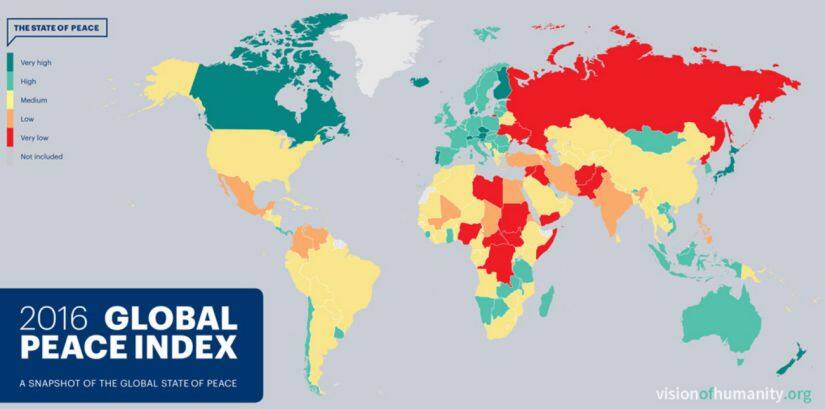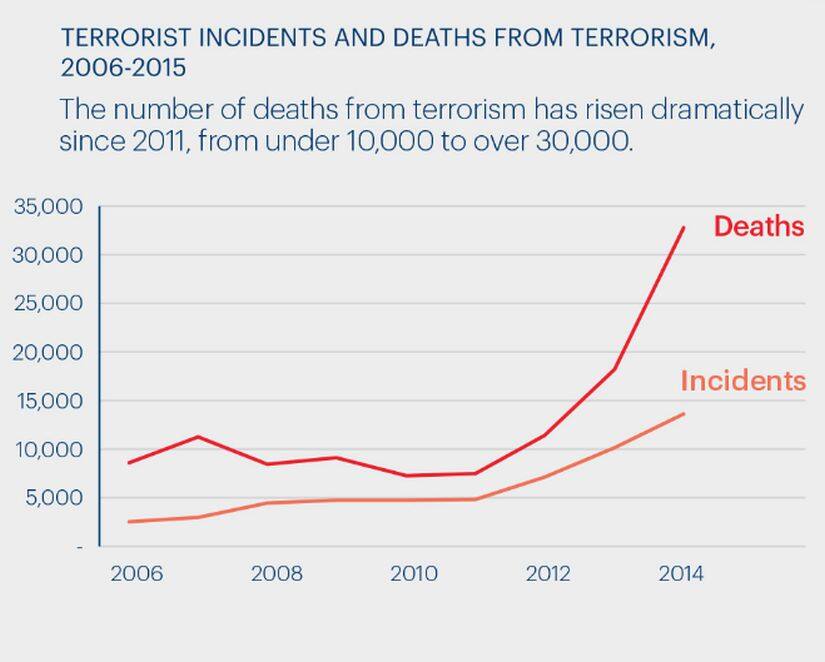In the 2016 Global Peace Index (GPI) curated by The Institute of Economics and Peace (IEP) think tank, India ranks at an abysmal 141 out of the 164 countries, trailing Mexico. The index gauges the level of safety and security in society, the extent of domestic or international conflict and the degree of militarisation. The report says, “India’s scores for ongoing domestic and international conflict and militarisation have deteriorated slightly,” and that the country “remains vulnerable to acts of terror and security threats at its shared border with Pakistan.” According to the GPI report, the world has overall become a less peaceful place. It’s not all that surprising and seems to be reinforcing a 10-year-trend — terrorism and political instability are two of the main causes of the deterioration. The report highlights that terrorism is at an all time high and trends show that it has been growing steadily over the past decade. Major terrorist activity has been concentrated around Iraq, Nigeria, Afghanistan, Pakistan and Syria. Terrorism is only spreading — there are only 23 percent of countries that have not experienced a terrorist incident since WWII. Terrorist attacks in Paris and Brussels, increase in incidents of violence in Turkey and its neighbours are why Europe, though still one of the most peaceful regions, has shown a decline in overall peace. [caption id=“attachment_2826780” align=“alignnone” width=“825”]  Source: IEP[/caption] According the GPI report, this decline in world peace is rather historic and in fact interrupts the improvements and strides in securing peace since the end of World War II. Middle and North East African (Mena) regions have seen intense conflict in the last ten years. And in the last 60 years, the number of refugees and displaced people are at a record level. In a press statement, Steve Killelea, the founder of IEP said, “As internal conflicts in MENA become more entrenched, external parties are increasingly becoming more involved and the potential for indirect or ‘war by proxy’ between nation states is rising. This was already evident in Syria with the conflict between the Assad regime and multiple non-state actors, and is now spilling into countries such as Yemen. There is a broader proxy conflict between Saudi Arabia and Iran, and more recently both US and Russia have increased their level of involvement.” [caption id=“attachment_2826794” align=“alignnone” width=“825”]  Source: IEP[/caption] The South Asian region as a whole has not changed from it’s position. The report suggests that internal security concerns heightened in Bangladesh and Nepal — detainees have increased owing to protests against the government. Madhesis, who are largely of Indian-origin, led a nearly six-month-long violent protest over better representation in the Nepal Parliament and the federal structure of the new Constitution that divides their ancestral homeland. The protests claimed over 50 lives before being called off unexpectedly. And another factor that could explain the deterioration in Bangladesh is the recent and frequent killing of people in the region by Islamist militants. Pakistan remains in a bad position on the index, owing primarily to the influence of Taliban from Afghanistan. Sri Lanka is the only country that did really well on the index from the South-Asian region, ranking at 115 (jumping ahead by 31 ranks from 2008), the report alludes this increased peacefulness to Sri Lanka bettering its relationships with its neighbours, especially India. The silver lining of this dark conflict ridden cloud is that there have been great strides made by the international community as a whole to provide funding and support to peacekeeping operations and the commitment to UN peacekeeping funding has increased by 12 percent. This signals the rise of an international community that values peace and is keen on building ties, maintaining peace and security.
In the 2016 Global Peace Index (GPI) curated by The Institute of Economics and Peace (IEP), India ranks at an abysmal 141 out of the 164 countries, trailing Mexico.
Advertisement
End of Article


)

)
)
)
)
)
)
)
)



